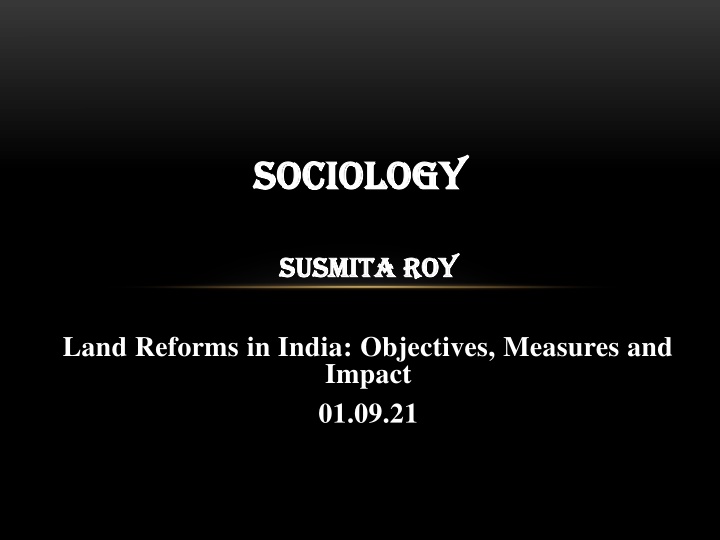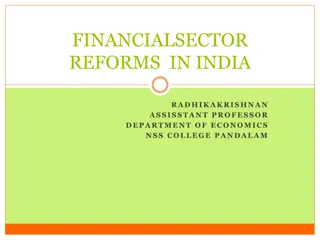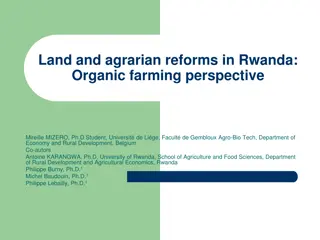Land Reforms in India: Objectives, Measures, and Impact
Land reform in India refers to institutional measures aimed at changing the ownership, tenancy, and management of land to improve agro-economic institutions. The objectives include achieving an egalitarian agrarian structure, eliminating exploitation, improving conditions for rural poor, and increasing productivity. Measures include abolishing intermediaries, implementing tenancy reforms, fixing landholding ceilings, and consolidating holdings. Despite progress, challenges like continued exploitation and absentee landlordism persist post-abolition.
Download Presentation

Please find below an Image/Link to download the presentation.
The content on the website is provided AS IS for your information and personal use only. It may not be sold, licensed, or shared on other websites without obtaining consent from the author.If you encounter any issues during the download, it is possible that the publisher has removed the file from their server.
You are allowed to download the files provided on this website for personal or commercial use, subject to the condition that they are used lawfully. All files are the property of their respective owners.
The content on the website is provided AS IS for your information and personal use only. It may not be sold, licensed, or shared on other websites without obtaining consent from the author.
E N D
Presentation Transcript
SOCIOLOGY SOCIOLOGY SUSMITA ROY SUSMITA ROY Land Reforms in India: Objectives, Measures and Impact 01.09.21
Meaning of Land Reforms: Land reform is a broad term. It refers to an institutional measure directed towards altering the existing pattern of ownership, tenancy and management of land. It entails a redistribution of the rights of ownership and/or use of land away from large landowners and in favour of cultivators with very limited or no landholdings. Thus, in a broad sense, land reform refers to an improvement in agro-economic institutions. It includes measures and policies relating to redistribution of land, regulation of rent, improving the conditions of tenancy, cooperative organisation, agricultural education, and so on. Objectives of Land Reforms: Land reform is a part of heritage of the country s freedom movement since the agrarian structure that we inherited from the British at the time of independence was of the feudalistic exploitative character. Zamindars- intermediaries-moneylenders played a big role in exploiting the masses.
It is in this background that we have to examine the objectives of land reform policy in India. Land reform measures aim not only at raising agricultural productivity. It is also viewed as a tool for social uplift. The major objectives of land reform package, as identified in the Eighth Plan, are: i. Restructuring of agrarian relations to achieve an egalitarian structure; ii. Elimination of exploitation in land relations; iii. Actualization of the goal of land to the tiller ; iv. Improvement of socio-economic conditions of the rural poor by widening their land base; v. Increasing agricultural production and productivity; vi. Facilitating land-based development of rural poor; and vii. Infusion of a great measure of equality in local institutions. In fine, growth and social justice are the basic objectives of land reform measures.
Measures of Land Reforms: The comprehensive land reform policy that evolved so far after independence consisted of: i. Abolition of intermediaries between the State and tenants; ii. Tenancy reforms that provide (a) security to tenants, (b) rationalisation and regulation of rent, and (c) conferment of ownership rights on tenants; iii. Fixation of ceiling on landholdings; iv. Consolidation of holdings; and (i)Abolition of intermediaries: Abolition of zamindari and similar intermediary tenures during 1950-55 essentially involved removal of intermediary levels or layers of various amorphous and parasitic groups in land between the State and the actual cultivators. However, such abolition of intermediaries involved compensation to the owners of land. As a result of this measure, about 2.5 crore farmers were brought into direct relationship with the State. This facilitated distribution of 61 lakh hectares of land to landless farmers. Large areas of privately-owned forests and wasteland now vested in the State.
Despite abolition of intermediary rights, poor peasantry continued to be exploited in various ways. It led to large-scale ejectment of poor tenants from land. While landlordism has been abolished, absentee landlordism now continues to flourish. The legislation conferred ownership rights not upon the actual cultivator, but on the statutory tenant, who himself was an intermediary with a chain of sub-tenants under him. All this happened because: (i) The law permitted the intermediaries to retain their home farms, (ii) No limit was put on the area of land they could retain, (iii) The term personalcultivation was ill-defined, and (iv) No protection was given to sharecroppers and other tenants-at-will. Thus, the abolition of intermediary rights on land has not been an unmixed blessing. Not every Y was crossed and every i was dotted, but the job was done. Undoubtedly, this zamindari abolition has paved the way for a remarkable shift in the balance of power. But the goal of land to the tiller is yet to be achieved. (ii) Tenancy Reforms: Tenancy legislations have taken three forms:
(i) Regulation of rent, (ii) Providing security of tenure, and (iii) Conferring rights of ownership for tenants. Rent payable to the landowners should not exceed one-fifth to one-fourth of the gross produce of land. In the light of this guideline, all the states have enacted laws for fixation of rent. However, large inter-state variations exist in the fixation of land rent rates. Further, one notices inter-state differences in land rents. Even the tenancy reforms have failed to regulate rent. Owing to the weak position of tenants, demand for fair and just rent from landowners occasionally lead to ejectment from land. Tenancy Legislations have made it clear that in no case the tenants can be evicted except only in the situation where landlords themselves want to resume cultivation. Even in the event of resumption of cultivation by the owners, tenancy legislations have made it obligatory to leave a minimum area for the tenant. Avery important aspect of land reform is the conferment of ownership rights to tenants in respect of non-resumable land. As a result of this measure, by 2000, only around 124.2 lakh tenants operating no more than 4 p.c. of the cultivated area have been benefited from this ownership rights or their rights have been protected on 63.2 lakh hectares of land.
On the eve of tenancy reforms, the area under tenancy was around 50 p.c. As a result of this action, this area has been reduced to 15 p.c. of the operated area by 2000. Overall impact of tenancy reforms has been rather limited. Firstly, tenancy laws have been violated. For instance, in Bihar, the maximum limit of rent was kept at 25 p.c. of the gross produce. But tenants are required to pay even more than 50 p.c. as their social standing is abominably low. Secondly, as regards the security of tenant- cultivator, escape clauses have been misused against the interest of tenants. Tenancy laws that have been framed in different states contained a provision for the resumption of land by the landowners for personalcultivation with the object of protecting the interests of landowners, rather than tenants. Due to a loose definition of the term personal cultivation, landowners continued to resume land for self-cultivation. The law also permitted the voluntary surrender of tenancies. Informal or concealed and oral tenancies are still prevalent. Thus, the right of resumption of land for self-cultivation has rendered all tenancies insecure. Finally, there is no legal provision for conferring ownership rights in the tenancy laws of some states. In reality, legislation for conferment of ownership rights could not yield good results because many tenants are incapable of buying land from the landowners and many of them are unwilling to do so.
(iii) Ceiling on Landholdings: To reduce the existing disparities in the pattern of land-ownership and make some land available for distribution to landless agricultural workers, the Second Plan (1956-1961) recommended the imposition of ceilings on agricultural holdings. It was envisaged that land above a certain limit would be acquired by the State and redistributed among the landless workers and small farmers so as to meet their hunger for land and, thus, to enable them to create economic holdings. Land ceiling laws were passed in two phases. In the first phase which lasted up to the end of 1972 landholder was treated as the unit of the cultivation. This ceiling unit was changed to family after 1972. The ceiling limits have also been lowered in the second phase with differences varying as between irrigated land with two crops, irrigated land with one crop, and dry land. But exemption for orchards, grazing land, cattle- breeding farms, religious/charitable/educational trusts, sugarcane plantations, tank, fisheries have made the ceiling laws virtually redundant.
Up to end September 2001, the total amount of land declared surplus was 73.67 lakh acres, 64.95 lakh acres of land have been taken over by the states. A total of 53.79 lakh acres of land have been distributed among 54.84 lakh tenants. This amounts to saying that about 12 lakh acres of land could not be distributed because of variety of reasons, of which litigation is considered to be the most inhibiting factor. The operations of the ceiling law made virtually no impact on the agrarian structure. The enforcement of the ceiling law was preceded by a public debate spread over several years. This enabled landowners to manipulate land records leading to fictitious (benami) and fraudulent partitions of lands among their relations, friends, fictitious trusts, etc. We have seen that the extent of area declared surplus is much less than the estimated surplus, mainly due to a wide range of exemptions provided in the ceiling laws, shortcomings and loopholes in the laws and inefficient implementation of the laws. As a result, only the small landowners were caught in the net and most of the big landowners or jotedars circumvented it and, even if the land was taken from them, it was not redistributed among the landless peasants. Lack of political will is considered to be the greatest stumbling block for its speedy implementation.
(iv) Consolidation of Landholdings: Fragmented and subdivided landholdings as well as small-sized holdings have made Indian agriculture un-remunerative. So consolidation of these lands is necessary to boost efficiency and economy in India s agriculture. It has been completed in the states of Punjab, Haryana and Uttar Pradesh. Till December 2001, nearly, 163.3 lakh acres of land or 1 /3rd of the total cultivated area have been consolidated. Thus, the success story in this regard is rather disappointing. One of the reasons for the tardy progress of this aspect of land reforms is that small farmers have a strong fear that consolidation favours large farmers. That is why the threat of eviction of tenants from land out of consolidation is the greatest. An Overall Appraisal of Land Reforms: After more than 60 years of independence, one notices some achievements in the sphere of land reforms. At the same time, our efforts in this direction have not yielded desired results. Most of the planks of land reform measures are ambivalent and there are large gaps between policy and legislation and between legislation and implementation. And land reform measures were conceived boldly but were implemented badly observed an expert.
The laws for the abolition of intermediaries had been implemented fairly well. As a result, 20 million cultivators were brought into direct relationship with the State. But this reform led to large-scale ejectment of tenants from land which they had been cultivating for generations as the laws failed to offer any protection to these masses. Thus, the slogan land to the tiller virtually remained unfulfilled. A class of neo- zamindars or absentee landlords has sprung up in rural India who grabs the produce of the earth as well as the land! It was hoped that tenancy reforms would ensure better results as far as the lot of tenants and sharecroppers were concerned. Tenancy reforms devised so far have not brought to an end of the system of absentee ownership of land nor have led to disappearance of tenancies.
Everywhere the immediate consequence was the ejectment of tenants on a massive scale. The consequence of the tenancy policy was to push tenancies underground. Most of the tenancies that still exist take the form of informal or concealed crop- sharing arrangements. Again, there are reports of large-scale evasion of ceiling laws because of non- implementation of the laws. For instance, in the district of Purnea of Bihar there are several landowners who own, and effectively control, at least 1,000 acres each, a few of them owning as many as 5,000 acres .. But land records show them to be owning not more than 15 acres the upper limit according to the ceiling laws the rest of land being transferred to mostly benamis (fake owners). [C. H. H. Rao]
To sum up, land reform programmes implemented since 1948 have not led to any radical distribution of land or removal of some of the obstacles to raising agricultural productivity. Nevertheless, it should not be written off as a non- event . It brought great changes. It did away with the numerous layers of parasitic intermediaries in almost all the states. All the measures listed above, however, have left untouched the bottom layer of the agrarian structure consisting of agricultural labourers, sharecroppers, except in the states of West Bengal and Kerala where left-wing political parties changed the destiny of the poor peasantry vis-a-vis the jotedars, are poor customers. Impact of the Land Reform Policy: Land reforms are being attempted for twofold reason: to improve production and productivity and the distribution of income/asset. Land reform measures are costless methods of increasing production in the agricultural sector. It serves the purpose of social justice too. Let us see how far land reform measures have improved productive efficiency of the agricultural sector and ensured social justice.
i. On productive Efficiency: So far as productive efficiency is concerned, the land reform measures adopted in recent years have not made any significant impact. The probable reason is that the reforms have not been effectively implemented. The ownership of land has not yet been fully transferred to the tillers. The actual rents still rule high. The consolidation of holdings has not been completed. Cooperative farming has not made much headway. In the- absence of economical holding being in actual possession of the tiller, in which he has a permanent interest, the modern techniques cannot be applied to land. Naturally, productivity continues to be low.
ii. On Social Justice: The objective of social justice has, however, been achieved to a considerable degree. The intermediary rights have been abolished. India no longer presents a picture of feudalism at the top and serfdom at the bottom. The tenancy laws have given the tillers protection from exploitation by providing them security of tenure and fixing maximum chargeable rents. It is true that the pace of implementation of land reform measures has been slow. Moreover, there is a marked unevenness in respect of progress in various states. This does not, however, mean that there has been no achievement at all in the sphere of land reform since independence. But the progress has been slow and it needs to be accelerated. The manifold problems of our land are to be solved through the introduction of a suitable land policy.























